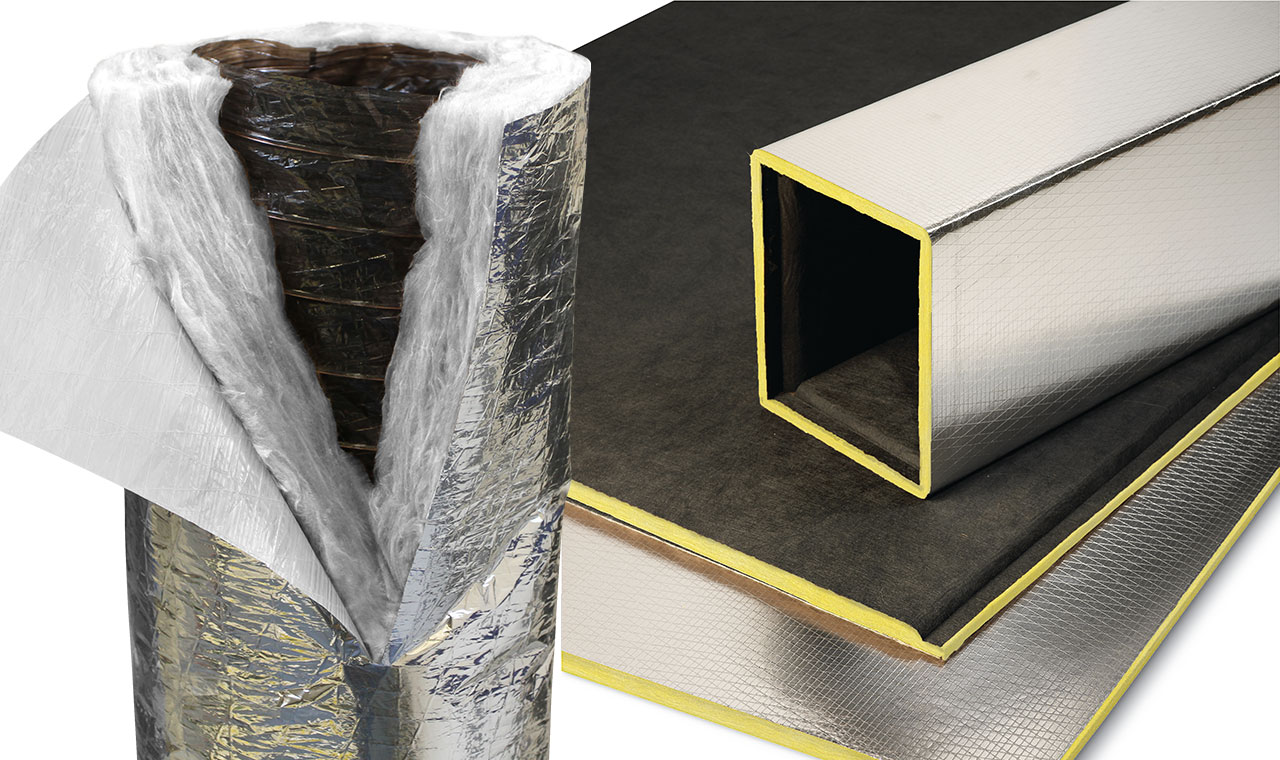When it comes to insulated forced air duct systems for residential applications, there are two systems that are commonly seen: flexible duct systems and duct board systems. It can be challenging to decide which system is right for a particular application, as both systems can be excellent solutions for the unique requirements and challenges often found in residential applications.
Flexible ducts are pre-insulated duct systems. They have an inner core built around a coiled wire frame. This core is wrapped in insulation, like JM’s Formaldehyde-free™ Flex-Glas®, and then the entire system is encased in a polymer or foil jacket. These systems often have a similar appearance to a dryer vent exhaust hose.
Duct board systems are made from a rigid fiberglass insulation board with a foil facing that has been fabricated into a duct by grooving channels into the board that allow the flat board to fold into a duct. Duct board systems are great for both thermal and acoustical control since they are made entirely from fiberglass insulation.
In considering which system might be right for your application, start by considering the unique benefits of each type of system.
Benefits of Duct Board Systems
- Lightweight: Since duct board systems are made entirely of rigid fiberglass and require no other components (aside from a UL 181-approved tape and outward-clenching staples), they are extremely lightweight when compared to many other systems.
- Excellent thermal and acoustical control: When you have a duct system that is made entirely of fiberglass, the system is inherently equipped for optimal thermal and acoustical control. These types of ducts are not prone to transporting sound, and they are well-equipped to maximize temperature control.
- Antimicrobial treatments: Both JM’s duct board products have an antimicrobial treatment designed to help protect them. On our Micro-Aire® Duct Board the glass-mat facing is treated with an antimicrobial agent to help protect it from potential damage that could be caused by mold and mildew growth. On our SuperDuct® RC the duct board is treated with JM’s proprietary, EPA-registered Permacote® antimicrobial coating. This coating creates a very smooth and efficient airstream surface, protects the fiberglass substrate from potential damage from mold and mildew growth, and creates a more water-resistant surface where small amounts of water are more likely to bead on the surface and evaporate than penetrate into the fiberglass substrate.
- Low-emitting: SuperDuct RC is GREENGUARD certified as a low-emitting product. If the home is designed to meet specific requirements for building design certifications, like LEED, this certification may play a significant role in material selection.
Benefits of Flexible Duct Systems
- Easy to install: Flexible duct is known as one of the easiest duct systems to install. This means that it’s likely that a professional installer will be able to install a high-quality system.
- Formaldehyde-free™ insulation: Some flexible ducts use JM’s Formaldehyde-free™ Flex-Glas® PC. This insulation is GEENGUARD® Gold certified, making it an excellent choice for homes that are looking to meet specific requirements, like those that might be found in LEED certifications.
- Great for unique spaces: Since flexible duct is flexible, it is a great solution for the unique spaces that homes often have. While other duct systems can be challenged by space requirements, flexible ducts are able to weave their way through the space with little hassle. However, bear in mind, excessive bends in the duct system can hinder efficiency, however.
- Single-piece duct branches: Since flexible ducts are typically a single piece of duct, there are fewer areas where air can escape from the system. This means that if the duct is installed properly and the beginning and ending joints are properly sealed, there is a low risk of excess air leakage.
Benefits of Hybrid Systems:
- Adaptable & Quiet: Hybrid systems couple the benefits of both systems into one. Designers can often get the thermal and acoustical benefits of the duct board where necessary, while using the flexibility and maneuverability of flexible duct where required. This makes the installation significantly easier without sacrificing in terms of performance.
- Lightweight: When compared to metal duct systems, both flexible ducts and duct board ducts are incredibly light weight. Utilizing a hybrid system capitalizes on the weight saving benefits which can be helpful in residential applications.
As with all comparisons, there are things you need to watch out for, and with flexible ducts, duct boards, and hybrid systems, the watch out is the same: the installation. A high-quality installation is critical to the success of any duct system, including each of these systems. It is worth noting that we often see duct system selection that is based largely on geographical location. In some areas there may be a preference for all duct board systems, in others all flexible duct systems, and in some, hybrid systems that mix both flexible ducts and duct board are preferred.
If a flexible duct system is installed with excessive sagging or unnecessary bends, the installation will be hinder the system’s efficiency. To ensure flexible ducts are installed correctly, the Air Duct Council’s (ADC) Flexible Duct Installation Instructions should be followed. Similarly, if a duct board system is not properly fabricated, sealed, and the joints are not all taped correctly, the lost efficiency in the system can be significant. To avoid this, installers should comply with the duct board fabrication instructions laid out in NAIMA’s Fibrous Glass Duct Construction Standards.
Both flexible ducts and duct board systems are excellent choices for residential HVAC systems. If you need help selecting the right material for your application, please contact us.

